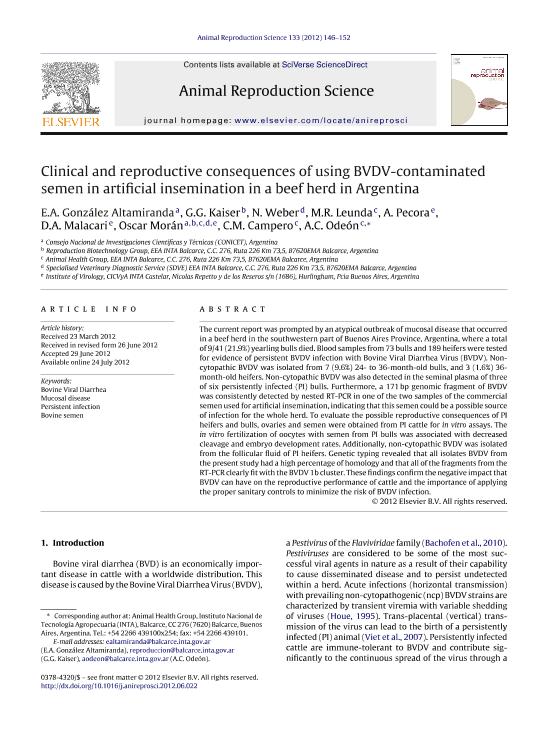Mostrar el registro sencillo del ítem
dc.contributor.author
Gonzalez Altamiranda, Erika Analia

dc.contributor.author
Kaiser, Germán Gustavo

dc.contributor.author
Weber, Natalia Alejandra

dc.contributor.author
Leunda, Maria Rosa

dc.contributor.author
Pecora, Andrea

dc.contributor.author
Malacari, Dario Amilcar

dc.contributor.author
Morán, Oscar Daniel

dc.contributor.author
Campero, C. M.
dc.contributor.author
Odeón, Anselmo Carlos

dc.date.available
2020-05-11T16:55:21Z
dc.date.issued
2012-08
dc.identifier.citation
Gonzalez Altamiranda, Erika Analia; Kaiser, Germán Gustavo; Weber, Natalia Alejandra; Leunda, Maria Rosa; Pecora, Andrea; et al.; Clinical and reproductive consequences of using BVDV contaminated semen in artificial insemination in a beef herd in Argentina; Elsevier Science; Animal Reproduction Science; 133; 8-2012; 146-152
dc.identifier.issn
0378-4320
dc.identifier.uri
http://hdl.handle.net/11336/104772
dc.description.abstract
The current report was prompted by an atypical outbreak of mucosal disease that occurred in a beef herd in the southwestern part of Buenos Aires Province, Argentina, where a total of 9/41 (21.9%) yearling bulls died. Blood samples from 73 bulls and 189 heifers were tested for evidence of persistent BVDV infection with Bovine Viral Diarrhea Virus (BVDV). Non-cytopathic BVDV was isolated from 7 (9.6%) 24- to 36-month-old bulls, and 3 (1.6%) 36-month-old heifers. Non-cytopathic BVDV was also detected in the seminal plasma of three of six persistently infected (PI) bulls. Furthermore, a 171 bp genomic fragment of BVDV was consistently detected by nested RT-PCR in one of the two samples of the commercial semen used for artificial insemination, indicating that this semen could be a possible source of infection for the whole herd. To evaluate the possible reproductive consequences of PI heifers and bulls, ovaries and semen were obtained from PI cattle for in vitro assays. The in vitro fertilization of oocytes with semen from PI bulls was associated with decreased cleavage and embryo development rates. Additionally, non-cytopathic BVDV was isolated from the follicular fluid of PI heifers. Genetic typing revealed that all isolates BVDV from the present study had a high percentage of homology and that all of the fragments from the RT-PCR clearly fit with the BVDV 1b cluster. These findings confirm the negative impact that BVDV can have on the reproductive performance of cattle and the importance of applying the proper sanitary controls to minimize the risk of BVDV infection.
dc.format
application/pdf
dc.language.iso
eng
dc.publisher
Elsevier Science

dc.rights
info:eu-repo/semantics/openAccess
dc.rights.uri
https://creativecommons.org/licenses/by-nc-sa/2.5/ar/
dc.subject
BOVINE VIRAL DIARRHEA
dc.subject
MUCOSAL DISEASE
dc.subject
PERSISTENT INFECTION
dc.subject
BOVINE SEMEN
dc.subject.classification
Ciencias Veterinarias

dc.subject.classification
Ciencias Veterinarias

dc.subject.classification
CIENCIAS AGRÍCOLAS

dc.title
Clinical and reproductive consequences of using BVDV contaminated semen in artificial insemination in a beef herd in Argentina
dc.type
info:eu-repo/semantics/article
dc.type
info:ar-repo/semantics/artículo
dc.type
info:eu-repo/semantics/publishedVersion
dc.date.updated
2020-05-04T17:17:53Z
dc.journal.volume
133
dc.journal.pagination
146-152
dc.journal.pais
Países Bajos

dc.journal.ciudad
Amsterdam
dc.description.fil
Fil: Gonzalez Altamiranda, Erika Analia. Instituto Nacional de Tecnología Agropecuaria. Centro Regional Buenos Aires Sur. Estación Experimental Agropecuaria Balcarce. Área de Investigación en Producción y Sanidad Animal; Argentina. Consejo Nacional de Investigaciones Científicas y Técnicas. Centro Científico Tecnológico Conicet - Mar del Plata; Argentina
dc.description.fil
Fil: Kaiser, Germán Gustavo. Instituto Nacional de Tecnología Agropecuaria. Centro Regional Buenos Aires Sur. Estación Experimental Agropecuaria Balcarce. Área de Investigación en Producción y Sanidad Animal; Argentina
dc.description.fil
Fil: Weber, Natalia Alejandra. Instituto Nacional de Tecnología Agropecuaria. Centro Regional Buenos Aires Sur. Estación Experimental Agropecuaria Balcarce. Área de Investigación en Producción y Sanidad Animal; Argentina
dc.description.fil
Fil: Leunda, Maria Rosa. Instituto Nacional de Tecnología Agropecuaria. Centro Regional Buenos Aires Sur. Estación Experimental Agropecuaria Balcarce. Área de Investigación en Producción y Sanidad Animal; Argentina
dc.description.fil
Fil: Pecora, Andrea. Instituto Nacional de Tecnología Agropecuaria. Centro Regional Buenos Aires Sur. Estación Experimental Agropecuaria Balcarce. Área de Investigación en Producción y Sanidad Animal; Argentina. Instituto de Virología; Argentina
dc.description.fil
Fil: Malacari, Dario Amilcar. Instituto de Virología; Argentina
dc.description.fil
Fil: Morán, Oscar Daniel. Otra; Argentina
dc.description.fil
Fil: Campero, C. M.. Instituto Nacional de Tecnología Agropecuaria. Centro Regional Buenos Aires Sur. Estación Experimental Agropecuaria Balcarce. Área de Investigación en Producción y Sanidad Animal; Argentina
dc.description.fil
Fil: Odeón, Anselmo Carlos. Instituto Nacional de Tecnología Agropecuaria. Centro Regional Buenos Aires Sur. Estación Experimental Agropecuaria Balcarce. Área de Investigación en Producción y Sanidad Animal; Argentina
dc.journal.title
Animal Reproduction Science

dc.relation.alternativeid
info:eu-repo/semantics/altIdentifier/url/http://www.sciencedirect.com/science/article/pii/S0378432012002011
dc.relation.alternativeid
info:eu-repo/semantics/altIdentifier/doi/http://dx.doi.org/10.1016/j.anireprosci.2012.06.022
Archivos asociados
